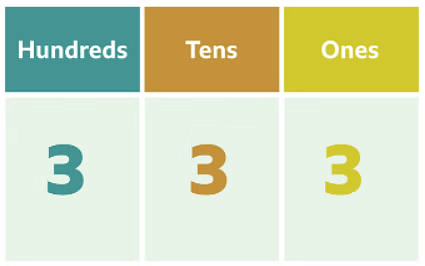Partition numbers to 1000 | Year 4 Mathematics PDF Download
What is place value?
- Definition of Place Value: Place value is a concept that helps determine the value of a digit based on its position within a number.
- Expressing Place Value: Place value is typically expressed in terms of hundreds, tens, and ones.
- Example of Place Value: Consider the number 333 which can be broken down into 3 hundreds, 3 tens, and 3 ones.

This chart shows how the number can be partitioned into hundreds, tens and ones.
Partitioning Numbers
- Importance of Partitioning: Partitioning numbers is beneficial when working with addition or subtraction of larger numbers.
- Representation of Partitioning: Aside from using place value charts, numbers can be shown in various partitioned forms.
- For instance, 333 can be represented as 300 + 30 + 3, illustrating 3 hundreds, 3 tens, and 3 ones.
Base model: Place value model:
Place value model: Part-whole model:
Part-whole model:
Solved Examples
Example 1:
Now let's partition the number 679.
To partition a number, you have to look at how many hundreds, tens and ones there are.
679 has 6 hundreds, 7 tens and 9 ones.
600 + 70 + 9 = 679
You could also say that 679 is made of 67 tens and 9 ones or 679 ones!
Example 2: Which picture does not represent 523?
Take a look at the pictures below. Can you see which one does not represent 523?
A. B.
B.
C.
Work out what each picture is representing, first.
A. The part-whole model shows 500 + 20 + 3. That equals 523!
B. There are 5 hundreds, 3 tens and 2 ones in the place value counters. That creates the number 532.
C. The Base 10 shows 5 hundreds, 2 tens and 3 ones. That's 523.
So B, the place value counters, do not represent 523.
|
69 videos|70 docs|11 tests
|
FAQs on Partition numbers to 1000 - Year 4 Mathematics
| 1. How are the 1000 UK schools divided for the exam? |  |
| 2. What factors are considered when partitioning the 1000 UK schools? |  |
| 3. How are students assigned to a specific partition of schools for the exam? |  |
| 4. Can students request to be placed in a specific partition of schools for the exam? |  |
| 5. How does partitioning schools for the exam help in ensuring fairness and equal opportunities for all students? |  |

|
Explore Courses for Year 4 exam
|

|

 Place value model:
Place value model: Part-whole model:
Part-whole model:
















